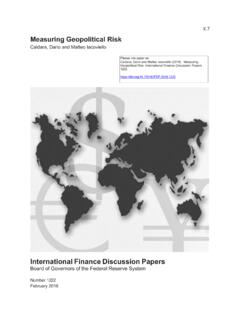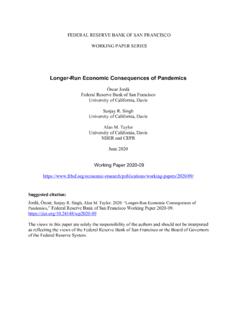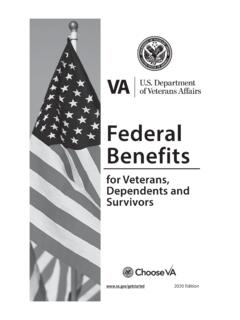Transcription of Monetary Policy and the Federal Reserve: Current Policy ...
1 Monetary Policy and the Federal reserve : Current Policy and Conditions Updated February 6, 2020 Congressional Research Service RL30354 Congressional Research Service SUMMARY Monetary Policy and the Federal reserve : Current Policy and Conditions Congress has delegated responsibility for Monetary Policy to the Federal reserve (the Fed), the nation s central bank, but retains oversight responsibilities for ensuring that the Fed is adhering to its statutory mandate of maximum employment, stable prices, and moderate long-term interest rates. To meet its price stability mandate, the Fed has set a longer-run goal of 2% inflation.
2 The Fed s control over Monetary Policy stems from its exclusive ability to alter the money supply and credit conditions more broadly. Normally, the Fed conducts Monetary Policy by setting a target for the Federal funds rate, the rate at which banks borrow and lend reserves on an overnight basis. It meets its target through open market operations, financial transactions traditionally involving Treasury securities. Beginning in 2007, the Federal funds target was reduced from to a range of 0% to in December 2008, which economists call the zero lower bound. By historical standards, rates were kept unusually low for an unusually long time to mitigate the effects of the 2007-2009 financial crisis and its aftermath.
3 Starting in December 2015, the Fed began raising interest rates. In total, the Fed raised rates nine times between 2015 and 2018, by percentage points each time. In light of increased economic uncertainty, the Fed then reduced interest rates by percentage points in a series of steps beginning in July 2019. The Fed influences interest rates to affect interest-sensitive spending, such as business capital spending on plant and equipment, household spending on consumer durables, and residential investment. In addition, when interest rates diverge between countries, it causes capital flows that affect the exchange rate between foreign currencies and the dollar, which in turn affects spending on exports and imports.
4 Through these channels, Monetary Policy can be used to stimulate or slow aggregate spending in the short run. In the long run, Monetary Policy mainly affects inflation. A low and stable rate of inflation promotes price transparency and, thereby, sounder economic decisions. The Fed s relative independence from Congress and the Administration has been justified by many economists on the grounds that it reduces political pressure to make Monetary Policy decisions that are inconsistent with a long-term focus on stable inflation. But independence reduces accountability to Congress and the Administration, and recent criticism of the Fed by the President has raised the question about the proper balance between the two.
5 While the Federal funds target was at the zero lower bound, the Fed attempted to provide additional stimulus through unsterilized purchases of Treasury and mortgage-backed securities (MBS), a practice popularly referred to as quantitative easing (QE). Between 2009 and 2014, the Fed undertook three rounds of QE. The third round was completed in October 2014, at which point the Fed s balance sheet was $ trillion five times its precrisis size. After QE ended, the Fed maintained the balance sheet at the same level until September 2017, when it began to very gradually reduce it to a more normal size.
6 The Fed has raised interest rates in the presence of a large balance sheet through the use of two new tools by paying banks interest on reserves held at the Fed and by engaging in reverse repurchase agreements (reverse repos) through a new overnight facility. In January 2019, the Fed announced that it would continue using these tools to set interest rates permanently. In August 2019, it stopped reducing the balance sheet from its Current size of $ trillion. However, the remaining MBS on its balance sheet would gradually be replaced with Treasury securities as they mature.
7 In response to turmoil in the repo market in September 2019, the Fed began intervening in the repo market and began expanding its balance sheet again in October 2019. With regard to its mandate, the Fed believes that unemployment is currently lower than the rate that it considers consistent with maximum employment, and inflation is running slightly below the Fed s 2% goal by the Fed s preferred measure. Monetary Policy is still considered expansionary, which is unusual at this stage of an expansion, and is being coupled with a stimulative fiscal Policy (larger structural budget deficit).
8 The decision to cut rates in 2019 was controversial. The Fed justified the cut on the grounds that risks of a growth slowdown had intensified and inflation was still below 2%. But it also argued that the economy was still strong, and some of the risks to the economy, such as higher tariffs, had not yet materialized at the time of the decision. Overly stimulative Monetary Policy in a strong expansion risks economic overheating, high inflation, or asset bubbles. RL30354 February 6, 2020 Marc Labonte Specialist in Macroeconomic Policy Monetary Policy and the Federal reserve : Current Policy and Conditions Congressional Research Service Contents Introduction.
9 1 Recent Monetary Policy Developments .. 1 How Does the Federal reserve Execute Monetary Policy ? .. 4 Policy Tools .. 4 Targeting Interest Rates versus Targeting the Money Supply .. 7 Real versus Nominal Interest Rates .. 7 Economic Effects of Monetary Policy in the Short Run and Long Run .. 7 Low Interest Rates and the Neutral Rate .. 9 Monetary versus Fiscal Policy .. 10 Unconventional Monetary Policy and the Fed's Balance Sheet during and after the Financial Crisis .. 12 The Exit Strategy : Normalization of Monetary Policy after 16 The Federal reserve s Response to Repo Market Turmoil in September 2019.
10 18 The Federal reserve s Review of Monetary Policy Strategy, Tools, and Communications .. 20 Figures Figure 1. Direct Fed Assistance to the Financial Sector .. 14 Tables Table 1. The Federal Funds Rate at the Peak of Expansions .. 2 Table 2. Quantitative Easing (QE): Changes in Asset Holdings on the Fed s Balance Sheet .. 14 Appendixes Appendix. Regulatory Responsibilities .. 22 Contacts Author Information .. 23 Monetary Policy and the Federal reserve : Current Policy and Conditions Congressional Research Service 1 Introduction The Federal reserve s (the Fed s) responsibilities as the nation s central bank fall into four main categories.

















